Issue 28, summer/fall 2019
https://doi.org/10.70090/FEK28KSC
Abstract
The main objective of this paper is to seek an answer to an important research question: Why did some communication campaigns on health and population issues in Egypt succeed, while others failed to make the desired impact on behavior and subsequent outcomes, such as reduced mortality or lower population growth over the last 40 years? Over the duration of these four decades, media campaigns have been launched in Egypt to tackle various health and population issues, but only some of these campaigns were grounded in communication theory and followed systematic methodologies. An analysis of evaluation studies and longitudinal data demonstrates that communication campaigns that were based on the Knowledge and Social Change Model (Elkamel 1981) have had a very positive impact on knowledge and behaviors, and helped save millions of lives, particularly those of women and children (Databank 2020; SRC 2012; El- Zanaty 2005; Moreland 2006). Other campaigns that were not based on the model were not as successful because they did not use appropriate media channels, missed the real target audience, and conveyed messages that were too general and did not address their need for knowledge (Parlato 1988; Eldin 2008). This paper reviews both types of campaigns: those that used the Knowledge and Social Change Model, and those that did not, documenting their respective impact, and presenting an analysis of the cost-effectiveness and cost-benefit of different mass media and interpersonal communication initiatives. The article also provides key recommendations for future behavioral-change communication campaigns for health and population.
Introduction
The Oral Rehydration Solution (ORS), which saves children from child dehydration and likely death, was available in the Egyptian Ministry of Health centers since 1977, but after seven years of it being accessible to the public, the proportion of mothers who knew of the treatment did not exceed three percent, and only 1.5 percent had used it (Kamel N. 1984; SPAAC 1985). After a series of well-planned campaigns launched in 1983, targeting mothers and other caretakers, knowledge became almost universal and the majority of mothers used this newly-acquired knowledge to save their children, leading to a significant decrease in infant and child mortality in Egypt.
Similarly, family planning campaigns during the period from 1986 to 1992 resulted in a significant increase in the use of contraceptive methods, which lead to an unparalleled decrease in Egypt’s population growth rate (Databank 2020); other campaigns before and after that time period failed to have such an impact, and some even resulted in having no impact at all (Databank 2020; SRC 2012; Parlato 1988).
Until 2002, the communication campaign for polio eradication was not able to convince all caretakers of children to immunize their children, resulting in a rise of confirmed polio cases in the country (El-Zanaty and Associates 2002). When the communication strategy and messages were revised, the campaign resulted in a near-universal knowledge and significant increase in the percentages of immunized children, which eventually led to polio eradication from Egypt (El- Zanaty and Associates 2005; polioeradication.org 2020).
The main objectives of this paper are: 1) To demonstrate and analyze how, and why, some campaigns in Egypt achieved their targets while others did not, over an extended time period of 40 years; and 2) To explain how the model of Knowledge and Social Change was used to plan behavioral-change communication campaigns on various health and population issues. The analysis of these two points sheds light on the parameters for effective use of communication in health and population in future campaigns.
Theoretical Framework
The Knowledge and Social Change Model was developed in the early 1980s (Elkamel 1981), and tested on data from a representative national cluster survey sample of 2,000 households in Egypt. The model was used over the following years as a conceptual framework for planning several communication campaigns for oral rehydration, family planning, polio eradication and combating hepatitis C in Egypt, between 1983 and 2016. National surveys were carried out before and after all of these campaigns, except for the hepatitis C campaign, where a follow-up survey was not implemented due to budget constraints. This extremely rich database provides an abundance of evidence in lieu of ascertaining the model’s utility as a theoretical framework for planning behavioral-change communication campaigns.
The model is based on the idea that knowledge influences behavior, and most often determines it. Accordingly, well-planned communication strategies must be based on a careful consideration of the interrelationships between socioeconomic status, communication, knowledge, and behavior, in a context of other intermediate variables that include attitudes, social norms, and a set of “enabling” variables, such as demographics, need, product availability, affordability, and the effort required to undertake the behavior. Once these factors are considered together, campaigns can disseminate the necessary knowledge to those who need it most, and avoid creating or widening any existing knowledge gaps that may be shaped along socioeconomic status lines.
There are numerous theories and models that aim to explain and affect behavior change, however they do not all agree on the same mechanisms for change, though they have various elements in common. Furthermore, not all of these theories are intended as theoretical frameworks for behavioral change communication in particular, and not all are interested in health and population, per se. These theories include the Theory of Reasoned Action, the Health Action Process Approach, the Stages of Change Model, the Self-Efficacy Theory, the Diffusion of Innovations Theory, the Theory of Planned Behavior, and the Learning Theory, among others.
Some of these theories, however, are more relevant than others to the Knowledge and Social Change Model, and some of their elements may be useful and complementary to the model’s implementation process, including the Learning Theory, in all its different variations (Gestalt principles, conditioning, and social learning). The Theory of Planned Behavior, which was developed by Martin Fishbein and Icek Ajzen in 1980, considers beliefs, attitudes, and intentions as determinants of behavior; its general concept is relevant to the Knowledge and Social Change Model.
Many theories that addressed the issue of behavior formation and change, however, have arrived at the conviction that behavior is a function of attitude. Some of these conceptualizations are based on the assumption of rationality (Fishbein and Ajzen 1975), some have based their models on the need for cognitive consistency (Rosenberg 1960), balance (Newcomb 1953), or congruity (Osgood and Tannenbaum 1953). Furthermore, there are in fact those who see the relationship going in the opposite direction, from behaviors to attitudes, and assume that individuals form attitudes to rationalize their behaviors that have already taken place (Festinger 1957).
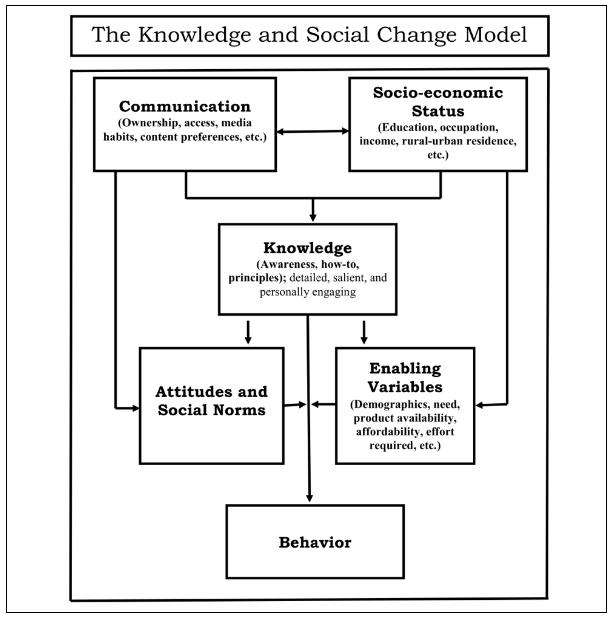
To various degrees, these approaches have been accused of being insensitive to socioeconomic conditions, and of being oriented towards an urban, educated, and Western types of populations (Bordenave 1976). The Knowledge and Social Change Model, on the other hand, considers “knowledge”, not attitude, as the central independent variable that affects behavior, and places attitude as an intermediate one instead. In addition, the model differs from other theoretical approaches in at least two other aspects: it is intended specifically for application as a framework for behavioral change communication campaigns in health and population, and has been shaped, tested and applied in a developing country where certain elements may be different than in Western environments, including (1) socioeconomic conditions, (2) the magnitude of influence by “significant others” on the individual’s decision-making process, (3) literacy levels, and (4) the availability and affordability of relevant products and services. Knowledge is defined in the model as information that is necessary for decision-making with regard to an object or behavior. It has to be: 1) valid, 2) detailed, 3) salient, and 4) personally engaging, in order to have a positive impact on behavior; all of these four aspects can be measured empirically (Elkamel 1981).
The first characteristic of knowledge in this model is validity. Validity distinguishes knowledge from certain other social psychological terms such as “beliefs” which are subjective in nature. The second characteristic of knowledge is that it has to be “detailed”, which means that knowledge is more than just “awareness”. This is consistent with Rogers’ assertion (1983) that the individual needs information that answers the following three questions: "What is the innovation?" "How does it work?" and "Why does it work?''. Therefore, there are three types or degrees of knowledge: “awareness-knowledge” which is an awareness of the existence of an object, “how-to knowledge” which consists of information on how the object works, and “principles-knowledge” which deals with the basic facts underlying why the object works the way it does.
The third characteristic of knowledge, namely, being salient, means that the individual is conscious of the object and has internalized the information to the extent that no prompting is needed to find out whether the person knows the object or not. For example, a family planning method such as the pill or IUD that is mentioned by an individual in response to the question “what are the family planning methods that a man or a woman can use?” would be considered as salient knowledge. On the other hand, the knowledge would be considered as non-salient if a method is not spontaneously mentioned by the individual, but is instead recognized by them, or is familiar to them, once they are given the choice to state whether or not they had heard of it.
The fourth characteristic of knowledge in this framework is that the person is self-involved or can be directly affected by this knowledge. In other words, information should be relevant to the person’s own desires, needs, or interests. For the vast majority of people, information on how the advocated behavior would benefit the individual person and/or his close family members would be more effective than information on how that behavior would affect other people, the country, or the world.
While knowledge is considered in this paradigm as an independent variable affecting behavior, it is also considered as a dependent variable that is affected by socioeconomic status and by communication. The relationship is more complex as both communication and socioeconomic status are themselves interrelated, making them have even more influence on knowledge. It is because of the interrelationships of knowledge, communication, and socioeconomic status that knowledge and behavioral inequalities are created, and it is the understanding of these intricate relationships, or lack of it that causes many communication campaigns to succeed or fail.
Of course, knowledge is not acted upon all the time. In this model, factors which interfere with the causal link between knowledge and behavior are termed intervening variables, and three classes of such variables are specified: social norms, attitudes, and enabling variables. Communication can also play an important role in influencing at least two of these intervening variables, namely, attitudes, and social norms, which would further enhance the possibility of acting upon knowledge. As the relationship between knowledge and behavior is also influenced by attitudes and social norms, a behavior-change communication campaign must also identify such factors and include messages that aim to develop and/or enhance positive attitudes and tackle the perception of social norms, in order to facilitate the relationship between knowledge and behavior.
Three significant challenges in sociology and communication literature can be resolved by this model. The first one concerns a rule that was professed by Everett Rogers (1983), regarding the effective role of mass communication vs. interpersonal communication. The second challenge stems from the phenomenon of the knowledge-gap or “information effects gap” that has been identified by Shingi and Mody (1976) and also reported by Rogers (1983: 409).
The Knowledge and Social Change model envisions that the comparison should not be between mass and interpersonal communication, but rather between messages with required knowledge, regardless of the means of communication, as long as such messages reach those who need them most, both effectively and efficiently. On the other hand, the so-called information gap is not inevitable and can be avoided by the careful consideration of the relationship between socioeconomic status and communication, on the one hand, and knowledge on the other hand. Careful consideration of mass media habits, preferences, as well as message design, development and testing could all circumvent the information gap, in order to suit the less advantaged segments of the population.
The third challenge applies to family planning in particular, and arises from the deep differences between two schools of sociologists and demographers regarding the need for family planning in general and its communication component in particular. On the one hand, there are those who consider family planning as necessary for social and economic development (Bogue 1967), and there are demographers who do not see any particularly important role for communication in fertility reduction. Their argument is that overall social and economic development will itself solve the problem of the population explosion. These authors have reached the conclusion that "population will take care of itself if you take care of it”, and that no communication activities on behalf of family planning are necessary (Davis 1963).
Demographers who are advocates of the development approach do not offer an explanation as to why education, urbanization, income, and other factors, would lead to a change in fertility behaviour; they only offered “associations” between such variables. The present model considers that knowledge is the mechanism through which socioeconomic development influences behaviour; it argues that, if socioeconomic development does not lead to a change in knowledge, behaviour is not expected to be influenced by socioeconomic status (SES).
First Testing of the Model
The first testing of the model was done on data collected from a national survey, the Egyptian National Family Planning Communication Baseline Survey (Elkamel 1981). The survey was conducted among 2,000 married men and women of reproductive age, between January and June of 1980. The urban and rural populations of Egypt were represented in the sample, according to the proportion of each in the population census of 1976.
It should be noted that even though the hypotheses and their empirical investigation in the first testing of the model (Elkamel 1981) were specific to fertility behavior- manifested in the use of contraceptive methods- the model was envisaged as having a wider scope as a framework. This is so that it could explain broader issues in communication and social development, especially when they involve behavioral change.
Findings of the National Family Planning Communication Baseline Survey (Elkamel 1981) supported all of the model’s arguments: It was found that low socioeconomic status groups have low levels of knowledge regarding family planning and its methods. Low levels of knowledge were also found to characterize groups with little access and low exposure to communication. Furthermore, low socioeconomic groups and individuals were found to have little access and exposure to communication, as well as different media habits (Elkamel 1981).
Using a quasi-experimental design, data analysis was executed using various statistical tools such as three-way and four-way cross tabulations as well as regression and factor analysis, with the aim of examining the likelihood of practicing family planning under varying combinations of knowledge, communication and socioeconomic status. The findings were solidly consistent in support of the major hypothesis. Thus, it was established that family planning behavior is more likely under high levels of knowledge (even if levels of socioeconomic status are low), than it is under low levels of knowledge (even when levels of socioeconomic status are high). The positive relationship between knowledge and behavior was established in all socioeconomic subclasses. A challenging conclusion of the analysis was that a rural, illiterate, and poor person who acquires a high level of knowledge of family planning was more likely to have practiced, to be practicing, and to intend to practice family planning methods than an urban, educated, and rich person who did not have a high level of knowledge about family planning. This is illustrated in table (1) below (Elkamel 1981: 93-94).
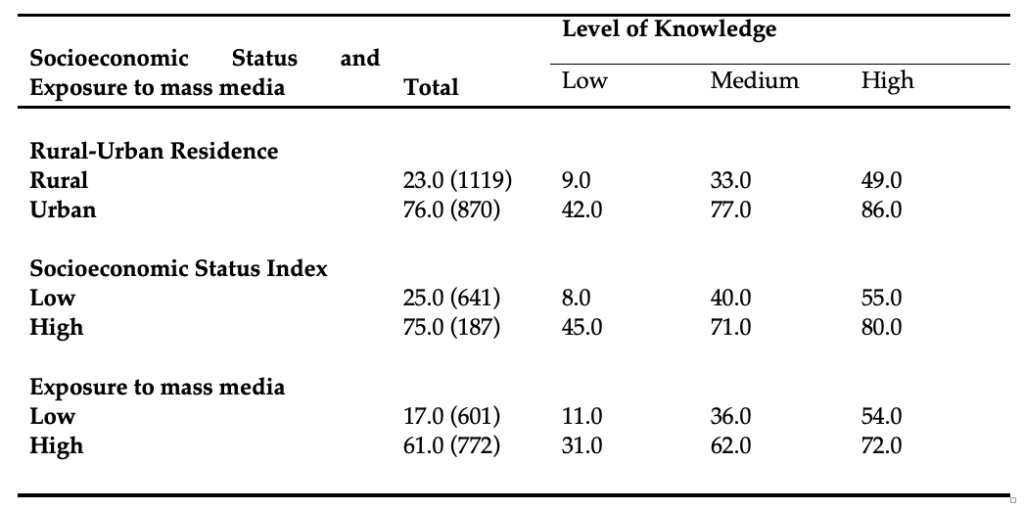
Table (1) Percent using family planning methods under different situations of knowledge, socioeconomic status and exposure to mass media *
* All Differences are significant at less than 0.01
Applying the Model in Health and Population Campaigns
Good planning of development communication for health, population and the environment should empower the less advantaged segments of the population with the necessary knowledge, to undertake the desired positive behavior. As mentioned above, this can be achieved if the communication effort is based on a careful analysis of the interrelationships between relevant variables in the Knowledge and Social Change Model. It is within this theoretical framework that family planning, oral rehydration and polio eradication campaigns that have been undertaken in Egypt during the last 40 years, will be discussed and analyzed in the remainder of this article.
The methodology utilized here in presenting and analyzing three case studies, relies on data that has been published by various researchers, national institutions, and international databanks, utilizing findings of national surveys, census data as well as vital statistics. Many of the campaigns that are reviewed in this article were based on the theoretical framework described above, however, some were not, therefore the utmost level of transparency and scientific integrity is observed in presenting the results and impact of all campaigns. The paper excludes research findings of studies conducted by the author; in order to remain completely objective, it only uses research data and results that have been collected and published by other researchers and institutions.
CASE I: The Oral Rehydration Therapy (ORT) Campaign: 1983-1989
The Nile River is the very lifeline of Egypt. Each drop of its water brings verdant life to the land and its people. The Egyptian farmer, who has cultivated this land for seven thousand years, knows this very well. He calls drought "Gafaf". This word has therefore become the most appropriate description for dehydration: the loss of bodily fluids and electrolytes necessary for life to continue.
Until 1983, Egypt lost about 150,000 children due to dehydration, annually. This accounted for half the deaths of children under the age of five (NCDDP 1983). This tragedy can be averted by treatment with a simple mixture of salt, sugar, and water, called Oral Rehydration Solution (ORS) which has been available in all hospitals and primary healthcare centers in Egypt since 1977. Until 1983, however, the vast majority of mothers did not know what dehydration was, neither were they aware of the Oral Rehydration Treatment (ORT), which includes, in addition to ORS, continued breastfeeding (especially during diarrhea episodes), and/or giving the child plenty of liquids.
Due to their lack of knowledge on the issue, mothers were found to be using various incorrect methods to treat diarrhea, including depriving the child with diarrhea from liquids altogether. Moreover, at the time, the majority of physicians in Egypt, including pediatricians, did not believe in Oral Rehydration Therapy, and depended on intravenous solution for the treatment of dehydration. They also advised mothers to stop feeding or breastfeeding for 24 hours or longer, and heavily prescribed antibiotics and anti-diarrheal medications.
In 1983, the Ministry of Health initiated the National Control of Diarrheal Diseases Project (NCDDP). The author developed and supervised the implementation of the project’s communication campaign (Elkamel, F. Farag Elkamel YouTube Channel). The planning and execution of the campaign was based on the Knowledge and Social Change Model which was discussed above. The campaign’s decision to rely heavily on television was based on the fact that it existed in over 90 percent of Egyptian households at the time, and that about 50 percent of all Egyptians- including 70 percent of all adult women- were illiterate, and yet most of them had access to television sets (MEAG 1984). The message development and placement were also audience-driven, based on the model discussed above.
After the launch of a three-month pilot campaign, exclusively in Alexandria, between August and October of 1983, where radio was the main medium, a two-week nation-wide pilot was launched, but on national television, in January/February; using three public service announcements (PSAs), known also as TV spots. The first lesson learnt from the pilot campaign was the confirmation of the premise that television would be more effective than any other medium (Elkamel and Hirschhorn 1984).
The first main national TV campaign was launched in September, 1984. In addition to key messages on what dehydration was and how to recognize its signs, the campaign introduced the new product (ORS and ORT), including instructions on proper mixing and management, its importance for saving the life of a child, as well as a message on the cause of dehydration, and ways to prevent diarrhea. A series of annual TV campaigns soon followed until 1989, with messages being updated in response to follow-up surveys which aimed to evaluate each campaign’s impact and identify needs for new messages.
Impact on Knowledge and Behavior
Since the television advertising campaign for oral rehydration started in 1984, the Arabic word Gafaf, which previously referred only to drought, has come to mean bodily dehydration. The concept of dehydration became so well-known due to TV spots to the extent that renowned writer, Anis Mansour, articulated his astonishment in his daily column in Al-Ahram newspaper: "School children were asked in their final exams to write an essay on the drought, but they wrote about child dehydration instead" (Mansour 1986: 13).
According to national evaluation surveys, knowledge and the use of ORS dramatically increased as a result of the communication campaigns between 1983 and 1988 (Elkamel and Hirschhorn 1984; British Medical Journal 1985; SPAAC 1984, 1985, 1986, 1988; El-Rafie 1990). While both knowledge and practice of oral rehydration were practically nonexistent in 1983, the percentage of women who knew what ORS is increased to 94 percent in 1984, and 98 percent in 1988 (El-Rafie 1990). Use of ORS followed the same pattern, jumping to 50 percent in 1984, and then to 66 percent in 1988 (El-Rafie 1990). Furthermore, knowledge of correct ORS mixing, by those who knew of ORS, increased to 53 percent in 1984, and to 96 percent in 1988 (El-Rafie 1990). These findings are presented in table (2) below:

Baseline surveys that were conducted during the planning phase of the national ORT campaign in 1984 revealed that there was an interesting distribution of TV viewers’ exposure to drama series and Egyptian movies, where the percentages of those who watched the drama series and movies among females with little or no education were significantly higher than the percentages of those with higher education; and that the distribution of diarrhea infections had a similar pattern, where children of the less educated mothers had more diarrhea episodes (MEAG 1984; Kamel 1984). Other elements were designed to avoid creating the so-called “information-effects gap,” such as the casting of rural and underprivileged urban characters, and the careful choice of character dress codes and locations for filming the spots; the format of the TV spots was intentionally fabricated to mirror the format of TV series and movies, and their spots were placed right before the airing of series and films. Furthermore, simple language and visuals were used, and the spots were pre-tested before airing, to ensure that they were easily understood and culturally accepted by all segments of the audience, especially rural and illiterate caretakers of children.
The impact of these campaigns, which relied primarily on television, shows that television has succeeded in increasing knowledge and teaching skills, as well as changing behaviors, without creating knowledge gaps between the lower and higher segments of the population (MEAG 1984). Television was able to overcome the illiteracy hurdle and provide the much-needed health information and basic know-how to all segments of the audience. The desired impact was achieved as illustrated in table (3) below, which is derived from national survey data (SPAAC 1984; MEAG 1984). It is quite interesting that audiences with lower levels of education benefitted even more from the campaign since their media habits, literacy levels and cultural patterns were factored into the media development and planning. Contrary to results of many other communication campaigns, and contrary to the proposition of the Knowledge Gap Hypothesis (Donhue 1975), the less educated segments of the Egyptian population adopted this new innovation (ORS) even more than the more educated groups, as illustrated by these figures for ORS use after the 1983 and 1984 campaigns (MEAG 1984).

Impact on Infant and Child Mortality
Two years after the first campaign was launched, vital statistics and other data began to show the impact of the increase in knowledge of mothers, and the use of ORS on infant and child mortality. The British Medical Journal (1985) concluded that "the lives of more than 100,000 children have been saved in Egypt in what may be the world's most successful health education program," (p. 1249). The journal added: "the World Health Organization has been so impressed with the results of the Egyptian campaign that it is encouraging other countries to adopt similar programs," (p. 1249).
The following year, a team of eight Egyptians and 11 international experts from the Ministry of Health, USAID, UNICEF, and the World Health Organization reviewed the project and came up with the following conclusion: "Consistent with findings of a number of studies reported by the project, the review found impressive knowledge and use of ORT among mothers. Of 161 mothers interviewed during the review, 96 percent knew what a packet of ORS was used for, 82 percent said they used it and 71 percent knew some signs of dehydration. Of ORS users, 97 percent could correctly mix it” (Report of Second Joint Review 1986: 16). Furthermore, the report asserted that “it is apparent that the above findings can be attributed in large part to a well-planned and carefully implemented mass media campaign that is very largely channeled through television. The wise focus on the primary target audience, mothers, has resulted in creating a demand-driven system which has important positive implications for the sustainability of the project's achievements" (Report of Second Joint Review 1986: 23).
Upon completion of the project, The Lancet published a comprehensive article by El-Rafie et al. (1990: 334-338), which stated that "packets of Oral Rehydration Salts are now widely accessible; Oral Rehydration Therapy is used correctly in most episodes of diarrhea; most mothers continue to feed infants and children during the child's illness; and most physicians prescribe Oral Rehydration Therapy. These changes in the management of acute diarrhea are associated with a sharp decrease in mortality from diarrhea, while death from other causes remains nearly constant" (El-Rafie et al. 1990: 334). The article further documents the impact on mortality on the basis of census data and vital statistics: “Infant mortality rate due to diarrhea declined from 29.1 in 1983 to 12.3 in 1987, while non-diarrheal infant mortality rate declined during the same period by a very small fraction, from 35.6 in 1983 to 32.8 in 1987 (El-Rafie el al. 1989: 335).
Additionally, Ruth Levine (2007: 61) concluded that “the most pivotal component of the program was the social marketing and mass media campaign.” In absolute numbers, Levine (2007: 57) estimates that “because of the reduction in diarrheal deaths between 1982 and 1989, 300,000 fewer children died.”
In even more precise figures, Peter Miller and Norbert Hirschhorn (1995) calculate that 316,612 children have been saved in Egypt between 1982 and 1989, of whom 202,113 are infants and 114,499 are children between the ages of one and four.
Three years after the project ended, the Egyptian Demographic and Health Survey (EDHS 1992: 145) reported that “it is clear that knowledge is virtually universal; 99 percent of mothers know about ORS packets. Ever use levels are also high at 70 percent among all mothers.” In 1995, the EDHS found that 98.2 of mothers knew of the use of ORS packets for treatment of diarrhea (EDHS 1995). Ten years after the campaign ended, the (EDHS 2000: 157) reported that “virtually all mothers (98 percent) are aware of the availability of packets of oral rehydration salts that can be used to prevent dehydration.”
These research findings provide further indication that empowering mothers with the necessary knowledge and skills to treat their children and protect them from death due to dehydration, has resulted in positive change. The necessary care measures are instilled in the hearts and minds of child caretakers, and they continue to convey the knowledge and skills that they have acquired to the next generation of mothers.
CASE II: Family Planning Communication in Egypt, from 1979 to 2018
The Population Problem in Egypt
The population explosion in Egypt and other developing countries has been explained in the context of the theory of demographic transition, which refers to a historical shift from high birth rates accompanied with high infant death rates, to low birth rates accompanied with low death rates as societies become more developed. Although this shift occurred in Western countries, a fast decline of death rates in developing countries after World War II was not followed quickly enough by a decline in birth rates (Van Bavel 2013). The result was what came to be known as “population explosion.”
Family planning programs were conceived as an approach to respond to this phenomenon in order to accelerate the pace of decline in birth rate, and Egypt became one of the first developing countries to consider family planning to improve health and lower the population growth. In 1962, the government adopted a national charter which identified rapid population growth as a threat to the economic betterment of the Egyptian people, stating that rapid population increase “is the most dangerous obstacle that faces the Egyptian people in their drive toward raising the standard of living” (Makhlouf 2003: 236). In 1965, Egypt became the first country in the Arab world to launch an official family planning program. Despite the program’s early establishment, and a downward decline in the population growth rate for several years, political support was inconsistent and fertility remained high until the 1980s (Radovich et al. 2018).
More serious attention to family planning communication began in 1979, when Egypt launched the first national campaign through the newly established Information, Education and Communication Center (IEC), of the State Information Service (SIS). Over the course of 40 years from 1979 to 2018, various campaigns were launched and different approaches were utilized.
Family Planning Communication in Egypt: 1979-1985
This campaign relied mostly on print media despite the high level of illiteracy in Egypt at the time, and posters were placed in Cairo, regardless of the fact that the majority of the target audience were elsewhere. The campaign disseminated its main messages under these three slogans: (1) "Look around you, Egypt has a population problem; (2) "Small families live better"; and (3) "The choice is yours"(Parlato et al. 1988; SIS, CAPMAS, and SDC, Communicating Family Planning to Egypt,1982: 172-173). This was later supplemented by a four-minute-long television advertisement named “Hasaneen and Mohamadeen,” featuring a popular singer and two actors posing as brothers from Upper-Egypt, and the first one is miserable because he has seven kids, while the other brother who has only two, is happy and successful.
A follow up survey conducted two years after the campaign’s launch reveals the skewed diffusion of these messages among the different population groups in Egypt, as shown in Table (4). Even though the campaign was national, sizeable portions of the population did not receive any of the four messages mentioned above (SIS, CAPMAS, and SDC, 1982). Evidently, the knowledge gap that was created during these two years was wide, as illustrated by table (4), which is derived from the results of the 1982 follow up survey conducted by the Central Agency for Public Mobilization and Statistics (CAPMAS) in collaboration with the SIS and the Chicago based Social Development Center (SDC) (SIS, CAPMAS, and SDC, Communicating Family Planning to Egypt 1982: 172—173).
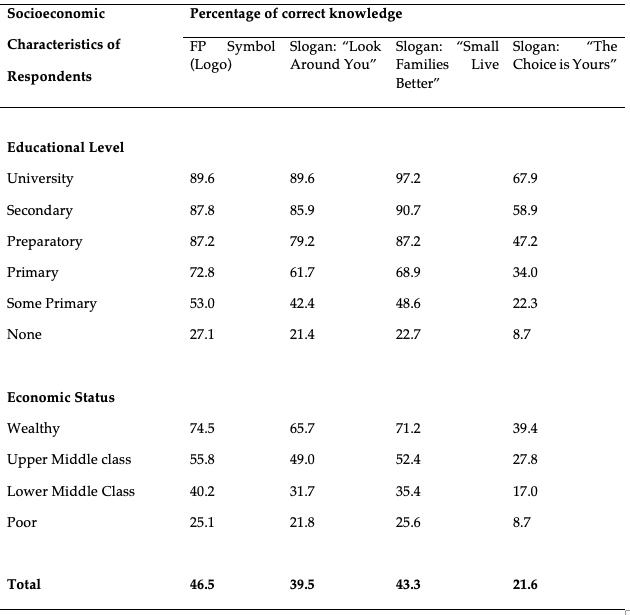
* All differences are significant at the 0.05 level. Source: SIS, CAPMAS, and SDC, Communicating Family Planning to Egypt, October 1982, p. 172—173.
Parlato et al. (1988) reported on the campaign which is described above as well as other SIS campaigns during the same phase. He concluded that:
between 1979 and 1986, SIS tried three different approaches to television advertising: the first through a popular song, the second through animation, and the third used a strong fear appeal. In addition to television advertising, SIS has continued to use posters, booklets, billboards, sponsored radio and TV programs, as well as interpersonal communication in the form of public rallies organized by the local offices of SIS. For most of this period, however, there were two conspicuous difficulties with message strategy for family planning: the lack of focused messages and a tendency to undervalue social science findings as a basis for message development. (Parlato et al. 1988: 19)
Donald J. Bogue also concluded that:
The radio and television messages in the late 1970s and early 1980s were broadly educational, stressing the theme of excessive population growth as a national problem, but made little effort to relate this national problem to listeners’ and viewers’ day-to-day social and economic concerns. The messages also lacked any specificity concerning contraceptive methods, benefits of use, sources of supply, or possible problems. (Robinson and El-Zanaty 2007: 27)
Longitudinal data which has become recently available (Databank 2020) indicate that there was no real impact on Egypt’s population growth during the period from 1980 to 1985. The rate was 2.319 in 1978, before the first campaign started, and continued to rise steadily throughout the life cycle of these three campaigns to reach 2.654 in 1985, which constitutes an actual increase of 14 percent in the population growth rate during that period.
Family Planning Communication in Egypt: 1986-1992
During the period from 1986 to 1992, the Knowledge and Social Change Model was the basis for formulating family planning communication in Egypt. The author conceived and produced the family planning campaigns in the country, including four national campaigns for SIS from 1987 to 1991 (Elkamel, F. Farag Elkamel YouTube Channel). These campaigns were designed to combat rumors on family planning generally and on specific contraceptive methods and their methods of use. The campaigns also discourage early marriage and promoted child spacing.
Parlato et al. (1988) reported the results of a survey of 1,800 households, evaluating the first of these campaigns, known as the 1987 “Zannana” campaign, in Table (5).
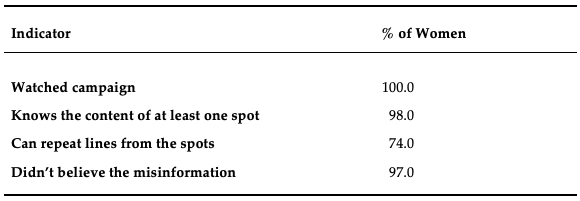
Interestingly, this campaign, like the aforementioned one on oral rehydration, challenged the “Communication-effects” or “Knowledge Gap” hypothesis and even reversed the professed ‘Knowledge Gap”. Table (6), derived from the above-mentioned study, shows how different educational segments learned from this campaign.
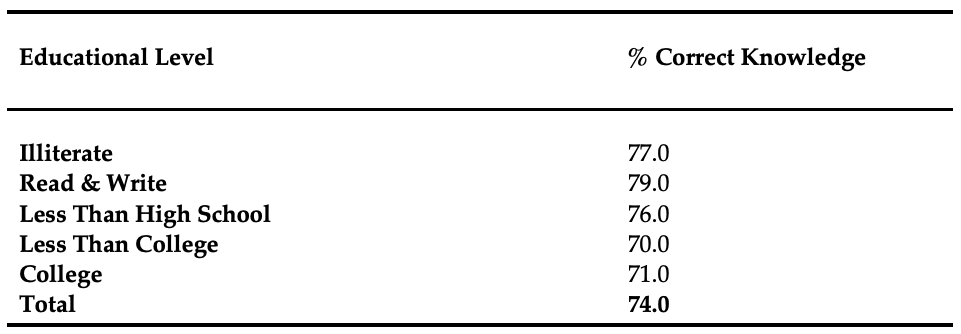
Table (6) Ability to Repeat Lines from the “Zannana” Campaign by Educational Level
Three subsequent national family planning campaigns were also developed on the basis of the Knowledge and Social Change Model between 1988 and 1990-1991. These campaigns went into more detail regarding correct use of contraceptives and how to deal with their possible side effects. They also added a new focus on tackling the undue blame on women by their husbands for not having baby boys; the availability and suitable selection of contraceptive methods and their correct use; health risks of early marriages; children’s rights; the need to consult a doctor; and the concept of planning itself.
This campaign was evaluated through a national survey of 2,400 cases which found no profound differences in the viewership of these spots between urban and rural residents, or those of different educational levels. The study also reported that the majority of viewers, regardless of their demography, were able to correctly repeat the campaign messages (Parlato 1988).
The 1989 campaign addressed more complex issues such as fatalism, the need to start child spacing after the birth of the first child, as well as men’s involvement and duty to support their wives in making family planning decisions. The 1990-1991 campaign focused on women in rural areas and addressed the issues of correct selection and use of contraceptive methods, and included a spot on how men should treat their women with respect and dignity. Most of the TV spots that were produced in this campaign continued to be aired throughout 1992.
Family Planning Communication in Egypt After 1992
Between 1993 and 2002, various initiatives such as the “gold-star” program and TV spots starring the famous actor Ahmed Maher were launched by the Ministry of Health with USAID support. This period also included another series of TV spots that were produced by the Ministry of Health. The following years witnessed more expensive undertakings, such as the USAID sponsored Communication for Healthy Living (CHL) project (2003-2008) and the “Wakfa Masrya” campaign (2008). In the CHL project, family planning messages were packaged with a very wide array of health messages. A comprehensive report on this period (USAID 2011: 14) acknowledged that “the upward trend in the [contraceptive prevalence rate] (CPR) has flattened since 2003, and the decline in [the total fertility rate] (TFR) has also slowed down, coming almost to a standstill between 2005 and 2008.”
The “Wakfa Masrya” campaign overlapped with the CHL program in the summer of 2008, when various ministries pooled resources for a new mass media campaign on family planning. The campaign resorted to the same tactics of the early 1980s and used slogans that were too general, which indirectly blamed the citizens for causing the population problem. Doriya Sharaf Eldin (2008), who was a member and spokesperson of the National Council for Women at the time, had several issues with this campaign. She asked several key questions: “Who engineered this campaign? Who chose that slogan? Who was it that scattered the messages on plenty of lampposts on bridges and neighborhoods that do not have a population problem? We need to know who did that in order to know who, in fact, is causing the population problem in Egypt.” She added, “I have asked some of those who would be typical targets of such a campaign if they had noticed any new advertisements on the streets. Most of them said that they didn’t, and the few who did said that they thought that the signs were promoting a new TV show.” (Al Masry Al Youm 2008).
It is evident that this campaign resembles the early 1980s campaign in several ways: They both used inappropriate media channels which missed the primary target audience for family planning campaigns, and they both disseminated messages that were too general and vague. A closer look at the slogans used in both campaigns reveals a recurring pattern. The early 1980s campaign used the slogan “Look around you…Egypt has a population problem,” and this campaign used the slogan “If we use our brains, we would all have food, clean water, good health,” which could be seen as government propaganda rather than effective family planning messages.
Results and Impact of Family Planning Communication Campaigns in Egypt
The Social Research Center (SRC) of the American University in Cairo (2012), reported on the changes in the use of contraceptive methods during the time span of 30 years. It concluded that “the trends of current use of family planning methods during the period 1984-2008 clearly show that the major jump occurred during the period of 1984-1992, where the rate increased more than 50 percent from 30.3 percent in 1984 to 47.1 percent in 1992.” (Social Research Center 2012: 13) The 1992 Egyptian Demographic and Health Survey (EDHS 1992) found that 73 percent of men and 71 percent of women cited television as their first source of information about family planning. In an interview with the Minister of Population and Family Welfare (Rakia 1994), he said that “the sharp increase in the rate of family planning practice from 38 percent in 1988 to 47 percent in 1992 could be attributed to the IEC program with convincing family planning messages, and particularly to the effective use of television, since the illiteracy rate is still high in Egypt.” Moreover, the “Population Situation Analysis” report by UNFPA (2016) on Egypt shows a sharp decrease in the crude birth rate (CBR) from 39.0 per thousand in 1987, to 29.0 per thousand in 1992. The importance of this increase of contraceptive use in causing a decrease in CBR and the subsequent impact on the population growth rate in Egypt has been investigated by Scott Moreland (2006), who concluded that “changes in the use of contraceptives is the single most important factor responsible for fertility decline.” (UNFPA 2016: 2)
The World Development Indicators (Databank 2020), which are compiled and published for all countries, provide valuable longitudinal data that reflect the variable impact of family planning and communication activities in Egypt during a period of 40 years from 1979 to 2018, as illustrated graphically in figure (2). The graph is published in the World Development Indicators (Databank 2020), and clearly shows that the 1980-1985 campaigns had no substantial impact on the population growth of Egypt. That is because the annual growth rate of Egypt’s population was 2.434 percent in 1980 when the first campaign was launched, and increased after that phase of communication campaigns. On the other hand, the graph shows that the rate had gone down to 2.048 percent in 1993, after the final airing of the four campaigns from 1987-1992, which is a remarkable decrease in the population growth by more than 24 percent. This rate of decrease in Egypt’s population growth during that time period was unprecedented and remains unmatched. It should be noted again that the Knowledge and Social Change Model was the basis of all family planning campaigns that were developed and implemented in Egypt between 1987 and 1992.These results reflect the impact of using this conceptual approach in planning and executing the campaigns on changing contraceptive behavior during this time period, which caused the decrease in the population growth rate.
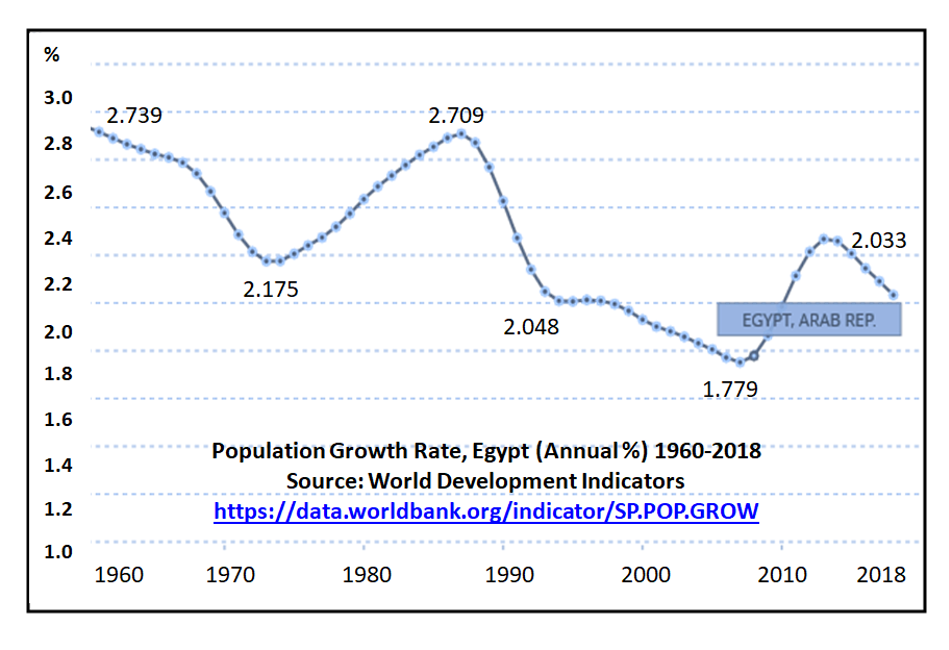
It should be noted that this decrease in the population growth was achieved despite the accelerated drop in infant and child mortality rates due to the campaign discussed earlier for oral rehydration that was taking place at the same time period. Finally, the graph shows that family planning campaigns had little or no impact on the population growth rate of Egypt during the period of 1993 to 2009. In fact, the graph demonstrates that over a period of 25 years between 1993 and 2018, despite various other campaigns during that period, the population growth rate of Egypt witnessed no change. The last documented annual rate of growth of Egypt’s population in 2018 was 2.033, which is almost the same as it was in 1993 after the series of campaigns from 1986 and 1992 that were discussed above. The UNFPA (2016) report “Population Situation Analysis” on Egypt confirms the finding stated above and asserts that “Egypt’s crude birth rate (CBR) dropped from 37 per thousand in 1985, to 30 per thousand in 1993, and that CBR remained almost unchanged as it fluctuated around 27 per thousand for nearly 17 years until 2010. Unfortunately, it then “started rising again and reached a peak of 31.9 per thousand in 2012,” (UNFPA 2016: 28), which is even higher than what it was in 1993. The significance of the UNFPA findings lies in the fact that the drop in the population growth rate during the time period of applying the Knowledge and Social Change Model (1987-1992), as represented in figure (2) above, correlates with the increase in contraceptive prevalence rate, and could not therefore be attributed to other causes such as a sudden sharp increase in the death rate or a remarkable decrease of the marriage rate, for example. The proper selection and use of contraceptives was the focus of most campaign messages during the same period (Elkamel, F. Farag Elkamel YouTube Channel).
Cost-Benefit of Family Planning in Egypt
Scott Moreland (2006) concludes that the benefits of family planning in Egypt until 2005 have been substantial, resulting in a population that is smaller by 12 million people. He calculated the cost-benefit analysis of the family planning program in Egypt and concluded that reducing the birth rate was achieved at a total cost of LE 2,402 million which were spent on family planning campaigns between 1980 and 2005. This amount, however, was “more than offset by the LE 45,838 million estimated cost savings in child health, education and food subsidies,” (Moreland 2006: 21) According to Moreland’s data (Moreland 2006: 4), the annual average of all expenditure on family planning during the period of 1987-1992 (which witnessed the best impact) was LE 64 million, while the average for the following 10 years was 136 million. It should be noted that the figures for expenditures mentioned here cover all aspects of the family planning programs in Egypt, including service, management, salaries of expatriates, local consultants, and logistics, in addition to communication (Moreland 2006: 20).
Impact of Family Planning on Mother and Child Mortality
The Egypt Demographic and Health Survey (EDHS 1988) concludes that “infant mortality decreases from 153 deaths per thousand births for birth intervals of less than two years to around 58 per thousand for birth intervals of two-three years or more. In addition, mortality is 31 percent higher among children born to mothers who are less than 20 years old” (EDHS 1988). It is even worse if the mother is even younger, as the UNDP reports that “if the mother is under the age of 18, her infant’s risk of dying in the first year of life is 60 percent greater than that of an infant born to older mothers.” (UNDP 2010: 80)
These differentials suggest that mortality risks for Egyptian children have been substantially reduced as a result of the key messages in the family planning communication campaigns. Moreland (2006: 21) concludes that Egypt’s family planning program during the last 25 years has led to a lower infant mortality rate. This program resulted in over 3 million fewer infant deaths and a lower mortality rate for children under the age of five, resulting in over 6 million fewer early childhood deaths as well as fewer maternal deaths, with 17,000 mothers’ lives saved.
Moreland, however grouped all family planning activities over a 25 year-period together, without distinguishing which ones had a bigger impact on saving lives than others. Given the data from the World Bank and UNFPA shown above, perhaps he or others may engage in such an exercise at some time in the future. The same applies to his calculations of resources that have been saved as a result of family planning during those 25 years. Further analysis and discussion of this and other findings in this section will be presented at the end of this paper.
CASE III: The Role of Communication in Polio Eradication from Egypt
The polio immunization effort began in Egypt in the 1990s, when routine polio vaccination was made available at no cost by the Ministry of Health facilities. The confirmed numbers of new polio infections kept declining, but then there was a state of alarm in 2001-2002. This downward trend was reversed, and the numbers of confirmed polio cases started to rise again. The numbers had gone down to only four cases in 2000, but then increased to five in 2001 and to seven in 2002. The subsequent anxiety was justified, since the World Health Organization could not declare a country as polio-free, even if only one case was detected; Egypt by then was one of only six countries in the world where polio was still present. What was believed to be the final step towards polio eradication in Egypt suddenly seemed longer.
El-Zanaty and Associates (2005) report that in 2002, the Technical Advisory Group (TAG), which consisted of Egyptian officials and international donors, called upon UNICEF to support the Ministry of Health in performing communication and social mobilization activities to complement the door-to-door strategy, in order to eradicate polio from Egypt. The author became chief communication Adviser to UNICEF in 2002, with the mandate to review and revise the course of the communication and community mobilization campaign where necessary.
The main issues and concerns that came out of the review, field visits and the baseline survey (El-Zanaty and Associates 2002) were the following:
- There was an exaggerated focus in the communication campaigns on addressing attitudes, when almost all caretakers had already held highly positive attitudes.
- The content of the communication campaign lacked advice for caretakers on how to make sure that the door-to-door vaccination drive did not miss their child.
- Extensive efforts and budgets were allocated to less appropriate media tools such as print, and inadequate attention was given to using more effective tools, including television spots and megaphones at the community level.
- The Ministry of Health staff were lacking the necessary strategies, plans, content and communication skills to implement effective community mobilization.
- The reported near-universal positive attitudes were obviously not sufficient to lead to the desired behaviors, which confirms the premise of the Knowledge and Social Change model that attitudes are important only as mediating variable between knowledge and behavior. Many caretakers had other problems such as misinformation that caused a reluctance to immunize their children, despite the expressed positive attitudes.
New Strategic Directions Since 2002
The revised communication strategy presented was based on the Knowledge and Social Change Model. That new strategy included the following three key components: 1) Revision of the communication strategy and the selection of means and channels of communication; 2) Revision of the content and message strategy; 3) Focus on using complementary effective community mobilization approaches in high risk communities where the last cases of polio were detected.
A. Revising the Communication Strategy and Media Selection
Media habits indicators, as measured in the baseline assessment (El-Zanaty and Associates 2002), showed that television had a much wider reach than both radio or print media. TV ownership had surpassed radio ownership in Egypt, as 93 percent of the baseline sample reported watching TV, compared to only 42 percent who listened to the radio. Only 8.5 percent of the sample said that they read newspapers and magazines on a regular basis.
The strategy revision did not involve any increase in the budget, in fact, the opposite was true. According to the exact figures which are reported by El-Zanaty and Associates (2005), the average annual communication cost during the years 2003-2005 was 43 percent lower than that of 2002. This was achieved through revising the media mix, as illustrated in table (7) below, which is constructed from data reported by El-Zanaty and Associates (2005).
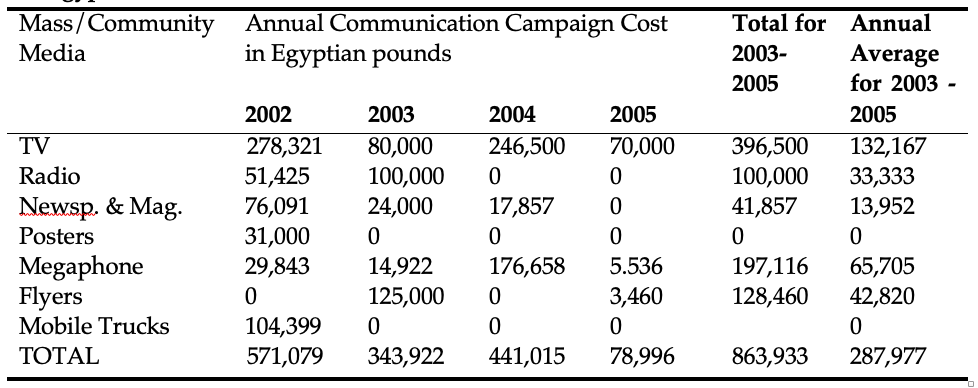
B. Revising the Message Content Strategy
Field reports and results of the national baseline survey of the 2,048 households that were completed in July 2002 (El-Zanaty and Associates 2002), showed that there were negative indicators which may have been responsible for the less than satisfactory results of the 2002 National Immunization Day (NID). These include the spread of various rumors and misconceptions about side effects of the polio vaccine. Other caretakers did not cooperate with the vaccination teams because they had already given their children one or two doses through the routine immunization program, assuming that was sufficient. The revised new message content for the 2003-2005 communication campaigns followed the knowledge typology (awareness, how-to, and principles knowledge) as described in the Knowledge and Social Change Model.
C. Strengthening Community Mobilization
The fallacy of interpersonal communication being more effective than mass media, as discussed earlier, has been challenged by the results of various successful mass media campaigns that have been reported above. It was pointed out that the comparison should rather be between well-planned and poorly planned campaigns. In this particular case, health authorities had identified several high-risk communities where the virus was still circulating in the environment, but the attempts to reach caretakers in those communities were not satisfactory. It was therefore necessary to upgrade the communication and community mobilization skills of the Ministry of Health staff through tailor-made curricula and training workshops for thousands of trainers and staff. It was also necessary to develop detailed plans to be implemented at the micro-level, specifying which means of community mobilization to use, and which messages to convey. The selected means to reach caretakers included schools through a child-to-parent communication approach, megaphones, health facilities, places of worship, and community organizations (social and sports clubs, businesses, NGOs, etc.). These approaches were in fact selected and prioritized by the caretakers themselves in a series of focus group discussions (Elkamel 2004: 28).
Results: Impact on Knowledge, Attitudes and Behaviors
Significant gains were made in knowledge, attitudes and behavior during 2003-2005, as shown in table (8) below, which is based on data reported by El-Zanaty and Associates (2005).
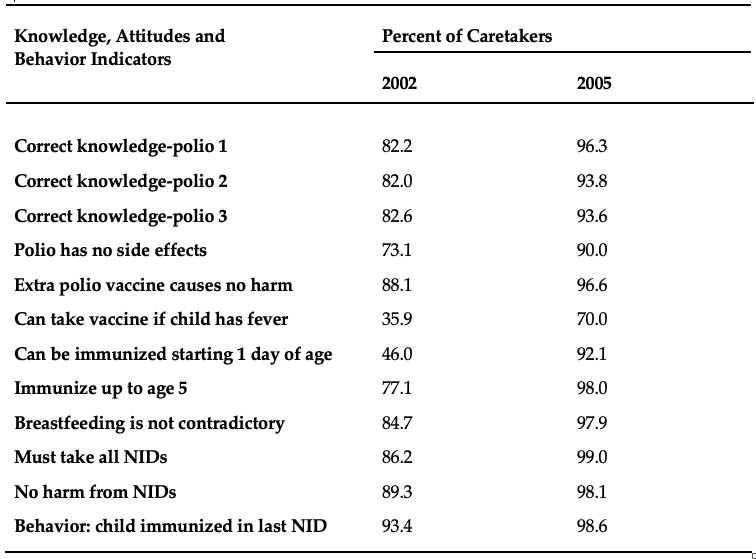
Impact on Polio Eradication:
Confirmed cases of polio started to decline in 2003 and then completely disappeared in 2005 (Centers for Disease Control). polio existed as far back as Ancient Egypt-evident on a stele depicting a priest with the disease’s symptoms-and for the first time it has been eradicated and Egypt was declared polio-free; this was announced by the Minister of Health and Population on August 29, 2005, and then by UNICEF/WHO on February 1, 2006 (UNICEF 2020).

Cost-effectiveness of Media Channels and Formats
Studies of cost-effectiveness of communication campaigns are quite rare. However, the evaluation of the polio campaigns examined the cost-effectiveness of the said campaigns. A follow-up survey was dedicated to this investigation, and is reported in detail in the El-Zanaty and Associates final report (2005).
Table (10) shows the number of caretakers motivated by different types of media, based on the results of the follow-up survey. The total number of caretakers surveyed in the follow-up survey was 1,549. According to the figures in the table, 72 percent of the caretakers in the survey who immunized their children were primarily motivated by TV spots, two percent were motivated by TV programs, two percent by radio, and seven percent by megaphones.

To estimate the number of caretakers in the September 2005 polio campaign who were motivated by the different types of media, an intricate methodology was used, as detailed in El-Zanaty and Associates report (2005). The estimates were based on the following: (1) number of immunized children during the September, 2005 National Immunization Day (NID), (2) number of children immunized in the sample surveyed in the follow-up survey, (3) number of caretakers who stated that they were motivated by the different media forms, to immunize their children, and (4) cost of each media form in the NID campaign.
The second row in the table presents the estimated number of motivated caretakers, by each of media form, based on their responses to the interview question on the source of their information on the NID. To compare the effectiveness of the different types of media used, the cost-effectiveness ratio of each media mean was derived by dividing the average cost per campaign for the relevant media used, by the estimated number of motivated caretakers. The last row of the table shows the cost-effectiveness ratios per 1000 responding caretakers for each type of media (El-Zanaty and Associates 2005: 60-61).
As shown in table (10) above, the medium with the best cost-effectiveness indicator is TV spots (LE 4.42 per 1000 motivated caretakers), followed by megaphones (LE 20.36 per 1000 motivated caretakers), then radio (LE 48.4 per 1000 motivated caretakers), and finally, regular TV programs (LE 78.36 per 1000 motivated caretakers). According to these results, TV spots are the most cost–effective medium, while regular TV programs are the least. It should be noted, however, that the cost of TV spots does not include the cost of airtime, which was donated by state-owned television channels.
Analysis and Discussion
The main objective of this paper was to asses why some communication campaigns on health and population issues in Egypt succeeded, while others weren’t able to induce behavior changes and subsequent outcomes such as immunization, reduced mortality or lower population growth. The paper reviewed three case studies where some campaigns were planned according to the Knowledge and Social Change Model, while others were not. The impact of all campaigns on behavior and subsequent outcomes was compared and measured according to published national and international data reports that were utilized as an objective and consistent yardstick.
While campaigns that were based on the aforementioned model were identified, it is not always clear what the other campaigns used as their theoretical frameworks. In the early 1980s, the family planning campaign used the slogan: “Look around you…Egypt has a population problem,” which presumably assumed that people would be motivated by such a nationalistic appeal to regulate their intimate behaviors. The same approach surfaced again and again, particularly in the 2008 “Wakfa Masrya” campaign, where grand slogans were also used on the assumption that people would stop having babies because the campaign promised that they would then have better transportation and enough to eat and drink. This kind of language may be expected from top leaders while discussing the country’s population problem with each other, but certainly not in a mass media campaign to change the individual behaviors of the audience.
It is possible to assume that the rationale behind such approaches could be rooted in the old socialist regime and manner that dominated the media and political scene at the time when television was introduced to Egyptian households in the 1960s; all media, including radio and television, were state-owned, and messages such as the ones mentioned above were considered normal. That school of thought does not seem to have gone away, even though the political and media systems have changed somewhat. The first campaign of the early 1980s was born inside the State Information Service (SIS), which is the communication arm of the government, and the 2008 campaign was sponsored by the cabinet in response to a comment made by Former President, Mubarak, that Egypt needs to have a “wakfa” or a stand against the persistence of the population explosion in the country. The campaign was tailored to reflect his words in a literal sense, apparently with little research or theory.
It is also evident that there may be an existing confusion with regards to message “targeting” in such campaigns. In addition to the fact that messages were too general and did not address the knowledge needs of the target audience, campaign materials seem to have been disseminated in such a way that they would be visible to officials and decision makers, rather than the real target audience. It would have been acceptable if the above- mentioned examples of messages and dissemination plans were targeting the decision makers themselves, with the objective, perhaps, to get them to support the family planning “policies”. However, it is certainly not acceptable to have those messages targeted at the average citizen who has to change his or her behavior in order to space their births or have fewer children. Such an individual needs a different message that reaches and empowers them with needed knowledge that is accurate, detailed, and self-engaging, instead of grand and vague slogans.
Another issue which is common to almost all of the campaigns that did not utilize the Knowledge and Social Change Model, is lack of audience research and dependence instead on “assumptions” that individuals would be motivated to regulate their health or reproductive behaviors based on messages that claim they would live happily ever after if they exercise birth control or take their children for vaccination. There is also an obvious fixation in those campaigns to portray a picture where the small family is happy and the large one is miserable. Self-defense mechanisms are triggered into action by such messages, which are more likely to be resented by the audience on religious and other grounds.
The nearly exclusive focus on attitude change also characterized some polio eradication campaigns, where TV spots before 2002 would repeat the images showing a child who is limping as a way to motivate parents to immunize their children against polio. No messages with “knowledge” of the sort that were included in campaigns since 2003 as described earlier were ever disseminated to the public in those earlier pre-2002 ones, which focused primarily on attitudes as if that was the only way to motivate caretakers, even if they still had concerns, apprehensions, and misinformation.
Furthermore, a burning issue with many of these campaigns seems to be the underestimation of what is needed to execute real “mass” education. The Oral Rehydration Solution had been available free of charge since 1977 in health facilities, but in 1983 only 3 percent of mothers of children ever knew that such a treatment ever existed. The so-called “let us make a poster” mentality was dominant during those years, where poor budgets were allocated and spent on less-effective media, as if the objective was simply to have it on paper that a communication effort had been made.
Even when campaigns enjoyed the availability of large budgets, there was lack of a clear and useful conceptual framework, as well as several other factors that prevented them from achieving the desired impact. One of these factors is the failure to utilize media channels and airing schedules that actually reach the majority of target audiences; and the erroneous prioritization of various kinds of print material for outreach, with questionable coverage and benefit in a country with high percentages of illiteracy, especially among women.
On the other hand, campaigns that utilized the Knowledge and Social Change Model benefitted from that conceptual framework in pinpointing the types of communication channels and formats that are optimum for reaching the primary target audience with specific messages that were derived from audience research on media habits and preferences, enabling variables as well as knowledge, attitudes, and practices. Messages were written in simple colloquial words, accompanied by familiar visuals, and were tested before dissemination to ensure that they would attract attention and be comprehended and internalized. There is a word of caution; however, that should be made here. The model of Knowledge and Social Change was applied in these campaigns by the inventor of the model himself, which meant that all aspects of the campaign were under strict quality control and were synchronized in a true adherence to the model. It is difficult to extrapolate whether or not the same outcome of these campaigns would be reached independently of such active involvement.
Conclusions and Recommendations
In the absence of a conceptual framework, communication efforts may very well be a shot in the dark. The Knowledge and Social Change Model has been useful as a framework; it worked consistently across various health and population issues, and over an extended period of time. While it is recommended to utilize it in future campaigns, it is also wise to realize that other models do exist, and that they may also be relied upon if they can deliver the same outcomes. This would certainly be an improvement over the common practices of not having any conceptual framework at all.
When adopting any conceptual framework, communication planners must be cautious with the expressions “to raise awareness” and “to disseminate knowledge”, which they seemed to use interchangeably, despite their clear distinctions. Unfortunately, many academicians, professionals and decision makers still consider “awareness” as “knowledge”, when it is only one layer of it, and one can still hear some voices who claim, for example, that all people “know this subject”, or that it is common knowledge, when in fact, they have mere awareness of the subject, treading only on the first layer of knowledge.
It was made clear in this paper that communication can literally mean the difference between life and death. Communication campaigns for health and population should therefore be taken seriously enough, which is not often the case. This seriousness is required in planning, utilization of a conceptual framework, campaign development and dissemination, budget allocation, and research support, among other things. Decision makers who control policy and budget are often government administrators, politicians or program managers who have their expertise in areas other than communication, but their decisions may shape the communication strategy and even determine its outcome. Therefore, they should consult experts on the extent of communication support required, and on communication strategies for specific subject matters, in order to allocate the required resources, select the most qualified and specialized producers, and maintain an enabling and supportive environment for their work. Some commercial advertising agencies or independent producers may not be familiar with the unique nature of communication for health and population and how it differs from typical commercial advertising. Such resources need to be coached by communication experts, to avoid making unnecessary and costly mistakes.
The political will of decision makers and those who are higher up in the hierarchy is almost a prerequisite for the success of communication campaigns for health and population. One important area that requires a genuine political commitment is budget allocation and free air time, the cost of which is often the single most important cause of inflating the budget of a campaign. The commitment and responsibility towards their own people require for top leaders to ensure the availability of free airtime to such campaigns. TV spots may have the largest line-item cost in a campaign budget, which often leads to either doing without them altogether, or reducing the frequency or duration of their airing, thus resulting in little or no impact. As mentioned earlier in this paper, cost-effectiveness analysis has demonstrated that TV spots can be the most effective media format by far; they are, in fact, the cheapest for of media communication in terms of per capita reach.
Communication needs an enabling environment to be able to deliver the expected outcome. The concept of “social marketing” has proved to be quite useful in campaigns that used the Knowledge and Social Change Model, as communication was bundled with other components, namely products, their pricing, and placement; communication was carefully synchronized with them. In brief, communication would be able to deliver the anticipated results if the promoted behaviors are made feasible by making products more easily available, accessible, affordable, and culturally acceptable, which is indicated in the “enabling variables” box in figure (1) of the Knowledge and Social Change Model.
Finally, theoretical issues that were raised concerning the uses of mass media vs. interpersonal communication and the “knowledge gap,” or “effects gap,” have been resolved: the so-called “knowledge gap” was avoided and reversed to the advantage of the less-educated and more information-deprived in the campaigns that utilized the model. On the other hand, mass media- mainly television- have also proved to be an arsenal for inducing positive outcomes when used in a context of an appropriate conceptual framework, vision, strategy and communication plan. Interpersonal communication was also utilized effectively in the context of the polio eradication campaign. The lesson that can be drawn from that experience is that interpersonal communication can be useful alongside mass media, but it is important to realize that it also requires the same good planning as mass media in order to become effective. For example, there is a need to empower those who implement it by identifying the most influential avenues of community outreach, proper communication skills, visual aids, a set of consistent messages, and logistical support.
 Arab Media & Society The Arab Media Hub
Arab Media & Society The Arab Media Hub





